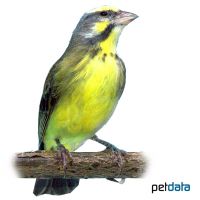Yellow-fronted Canary (Crithagra mozambica)
| Yellow-fronted Canary Crithagra mozambica | |
|---|---|
| Name | Yellow-fronted Canary |
| Name Lat. | Crithagra mozambica |
| Synonym | Serinus mozambicus |
| Family | Finches and Allies |
| Family lat. | Fringillidae |
| Order | Perching Birds |
| Order lat. | Passeriformes |
| Origin | Africa |
| Climate | Subtropical - tropical |
| Diet | Finch seed, veggies, insects |
| Keeping | Pair |
| Care Level | Easy |
| Reproduction | Cup nest |
| Life Span | 5-10 years |
| Protection | No |
| Metric Units | |
| Size | 11 cm |
| Temperature | Room temperature |
| Housing | 80 x 40 x 40 cm |
| US Units | |
| Size | 4.3" |
| Temperature | Room temperature |
| Housing | 30" x 15" x 15" |
Distribution and habitat
Mozambique Gargants are widespread south of the Sahara in West, Central and East Africa as far south as South Africa. They live in a variety of habitats, such as open gallery forests, tree savannahs and in grasslands with scattered trees and shrubs, as well as field margins, gardens and parks
Cage size
The minimum cage size is 80 x 40 x 40 cm (L x W x H) for a pair. The cage size must not be undercut even in case of justified single keeping. For additional 1-2 birds, provided species compatibility, the floor space must be increased by 25%. The cage must be placed in a bright, draught-free and quiet place at a height of at least 80 cm (except aviaries), have a rectangular base and be opaque on three sides, aviaries on one side. Keeping in an aviary is preferable.
Maintenance
The floor must be covered with sand, wood granulate, bark mulch or similar material and must be cleaned regularly. At least 3 perches made of wood or branches of varying thickness and height must be installed in such a way that they can only be reached by flying and that the longest possible flight distance is created. They need a bathing opportunity as well as biotope-like hiding, sleeping and nesting possibilities. It is recommended to provide them with grasses and bushes. They should be kept at room temperature.
Diet
The species-specific feed offer consists of mixed seeds, available in specialized trade as "Girlitzfutter" in premium quality, supplemented with foxtail millet, green feed (chickweed, green panicle millet, fresh grass panicles, organic lettuce etc.), tangle grass seeds, insect feed and especially for the raising of young germinated seeds (millet etc.).), tangle grass seeds, insect food and especially for raising young germinated seeds (millet, etc.), egg food and insect larvae, such as small, skinned, cut flour beetle larvae, ant pupae and aphids. Charcoal, vitamin lime and shell grit are needed as digestive aids. Drinking water must always be available in birdbaths or in stable, open containers. Food and water must be offered fresh daily, and the containers must be cleaned beforehand
A regular and varied diet promotes health and prevents deficiency symptoms.
Reproduction and breeding
The females have a blackish chain-like neck markings
They like to breed in biotope-like facilities such as open basket nests covered with brushwood and in nesting blocks or also freely in dense branches (e.g. broom, conifers). Suitable nesting material is nest wool, sisal, coconut fibers, small roots and fine feathers for padding. The breeding season is usually in the winter months from October to May. For breeding, the room temperature should be at least 15 °C.
Important
They must not be kept in a round cage. For group keeping, an aviary is required.
When kept in an outdoor aviary with a height of at least 1.70 m, they also require a heated shelter with a floor area of at least 1 m², which can be visited by the birds at any time. The temperature in the shelter must not fall below 5 °C and the furnishings must correspond to those of cage keeping.
Especially during the breeding season they are incompatible within the species and should only be kept in pairs. Socialization with other birds is possible
In rooms, including shelters, adequate daylight or flicker-free artificial light (stroboscopic effect) corresponding to daylight should be provided. The lighting duration shall be 8-14 hours per day and the natural day-night rhythm shall be observed. Adequate indoor climate shall be provided. The health condition of the birds shall be checked daily
Further literature can be found in your pet store.
References
Text: Othmar Sieberer; Image: petdata
Source: BMELV (1995): Tierschutzgutachten - Mindestanforderungen an die Haltung von Kleinvögeln; GRUMMT & STREHLOW (2009): Zootierhaltung - Tiere in menschlicher Obhut: Vögel, Verlag Harri Deutsch; CLASSEN & MASSOTH (1992): Handbuch der Cardueliden, Band 1, Hanke Verlag
- Gemäß § 21 Abs. 5 Tierschutzgesetz idgF
